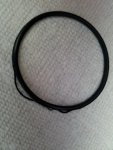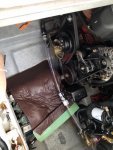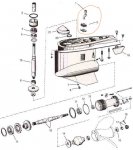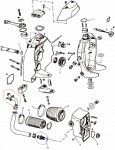ConchPirate
Seaman
- Joined
- Jul 20, 2011
- Messages
- 52
Engine - Port: 5.0GXi-E Model # 3869255/Serial # 4012105456/566 hours.
After first run with new to us boat, the port engine seawater pump began leaking out the bearing seal, but temp was fine and steady at 175 (and impeller was in great shape). Replaced the pump with a new unit and it seemed to be OK dockside. Next run while idling out the canal and with temp running at 175 for about 3 minutes it started climbing to 200. Put it in neutral and increased rpms and it began dropping, finally settling on 175. Once on the water ran up on plane, did a few minutes of WOT, back to 3Krpm, and temp stayed at 175 for entire remainder of the trip. Next trip -- same exact issue! 3rd trip -- same scenario. So today, I pulled the thermostat housing, boiled and cleaned it, installed a new 150° thermostat, put it all together and cranked it up dockside. Guess what -- SAME exact issue just sitting at dock! It gets to 175, holds for a minute, then heads to 200. Increase rpms for 15 seconds and it drops right back down and just stays at 175.
Welcome ideas as to what to check next. BTW - manifolds and risers were replaced in MAR 2019 by PO.
TIA/ Dave
After first run with new to us boat, the port engine seawater pump began leaking out the bearing seal, but temp was fine and steady at 175 (and impeller was in great shape). Replaced the pump with a new unit and it seemed to be OK dockside. Next run while idling out the canal and with temp running at 175 for about 3 minutes it started climbing to 200. Put it in neutral and increased rpms and it began dropping, finally settling on 175. Once on the water ran up on plane, did a few minutes of WOT, back to 3Krpm, and temp stayed at 175 for entire remainder of the trip. Next trip -- same exact issue! 3rd trip -- same scenario. So today, I pulled the thermostat housing, boiled and cleaned it, installed a new 150° thermostat, put it all together and cranked it up dockside. Guess what -- SAME exact issue just sitting at dock! It gets to 175, holds for a minute, then heads to 200. Increase rpms for 15 seconds and it drops right back down and just stays at 175.
Welcome ideas as to what to check next. BTW - manifolds and risers were replaced in MAR 2019 by PO.
TIA/ Dave























